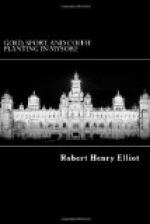The origin of the movement in India with reference to the introduction of a gold standard and forcing up the gold value of the rupee is shortly, and I believe very accurately, stated by Sir Frank Forbes Adam in his evidence given before the Currency Committee; and on November 26th, 1892, he told the Committee that “Though there is undoubtedly dissatisfaction existing among a certain number of those carrying on foreign trade, really the origin of the movement and its true force proceed from the servants of Government.” Of this, I think, there can be no doubt whatever; and it is important to remember that this movement did not originate with the people, or planters, or merchants, or manufacturers, or from any section of the producers and traders of India. The servants of the Government had a great and legitimate grievance, because they found that, though rupee prices in India were not to be complained of, they experienced a grievous loss on their home remittances, and it was their persistent agitation which created and maintained the true force of the movement. The agitation they thus originated was joined in by some of the merchants of India, though to what extent does not appear, and I can only say generally that the merchants who did join the movement were small in number. Bombay and Karachi were clearly against any interference with the currency; and from the expression of disappointment which fell from the Hon. Mr. Mackay—President of the Currency Association, Calcutta—with reference to the small number of his supporters, I am led to the conclusion that, with the exception of a certain proportion of Calcutta merchants, occasional individuals in other parts of India, and the servants of the State, all India was, and is, dead against the monetary policy of the Government. Of the twenty-two witnesses examined before the Currency Committee, thirteen were against the Government measure, six in favour of it (four of the latter being Government servants), two doubtful, and one presumably against the measure.




